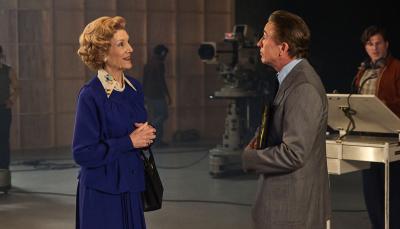Kate Winslet and Saoirse Ronan Shine in 'Ammonite'
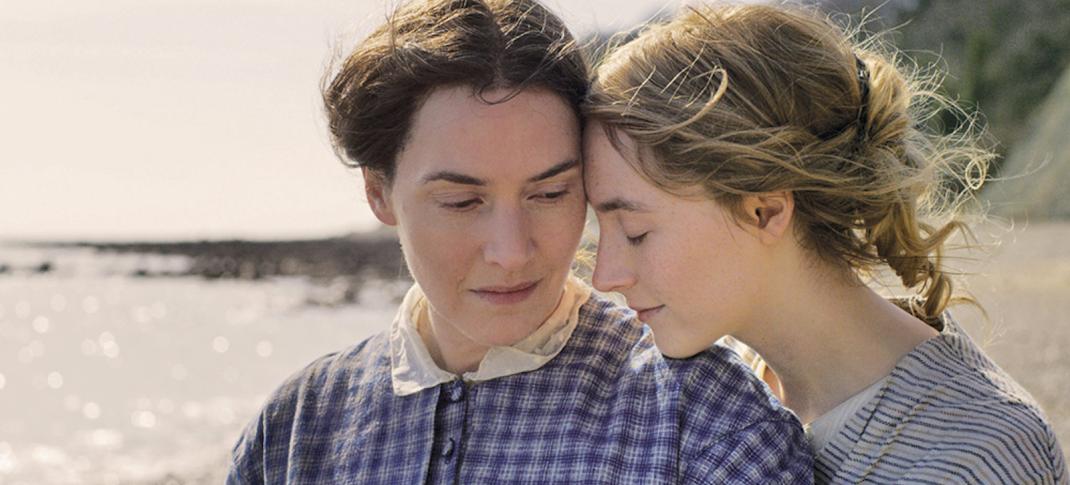
The 2020 film Ammonite is written and directed by Francis Lee and features a strong ensemble cast who perform the miracle of expressing emotion tempered with restraint, doing a lot with few words. It is a film about passion that is for the most part understated, with the eloquent palette and use of natural scenery and weather that characterized Lee’s God’s Own Country (2017). It reunites Gemma Jones and Kate Winslet in their first mother-daughter roles since the Oscar-nominated 1995 film Sense and Sensibility. James McArdle and Saoirse Ronan (Little Women) both starred in 2018's Mary Queen of Scots , and McArdle also appeared in recent HBO hit Mare of Easttown with Winslet. This fertile cross-pollination pays off in the ensemble acting, with brilliant performances by both Winslet and Ronan in the lead roles.
Lee does not even try to persuade the viewer that paleontologist Mary Anning (1799–1847) needed a love affair to round out her life (thank goodness). Instead, it’s a subtle, careful exploration of intimacy, work, and love.
The cinematography is gorgeous, from the fierce Dorset winds and tides to the interior shots of the Annings’ house, which have the richness and detail of a Dutch 17th-century interior. A ladybug explores a botanical print; we watch Mary (Winslet) and her mother (Jones) perform everyday household tasks; and Mary searches, cleans, and prepares fossils for sale, detailed and painstaking skilled work.
The film opens with the sound of rhythmic splashes, not that of the sea, as you’d expect, but of a woman scrubbing a floor—woman’s work, right? And that floor is in a museum, where some men are bringing in a new acquisition for display, a fossil ichthyosaur discovered by an obscure, lower-class eleven-year-old girl in Lyme, Dorset.
The sale of that fossil to the British Museum kept Mary and her widowed mother for a year. This was the Annings’ business, excavating and selling fossils, and decorating items like mirrors and boxes with shells. It’s clear that now in 1840 they are struggling; the household clues—a badly out-of-tune piano, their pretty lace collars, and caps—indicate that they were once better off. Her mother is fragile physically and emotionally.
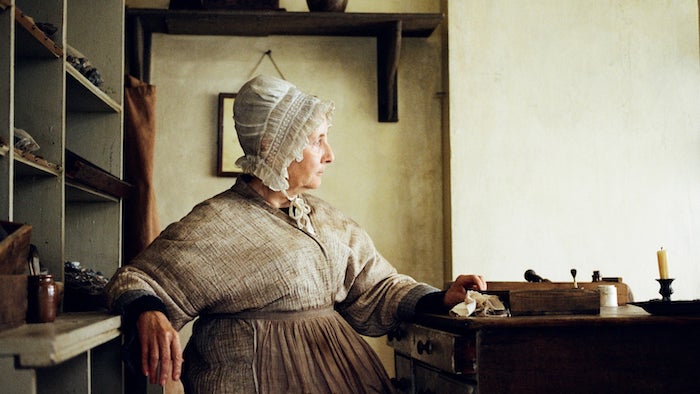
Mary gets on with things with a surly stoicism, striding off to dig for fossils on the muddy Dorset cliffs in grubby cottagecore gear. She’s decided not to search for major, large fossils; she’s after trinkets with which to fleece the tourists and sustain a steady income. She knows she’s denied recognition and status for her scientific work because it’s the territory of educated gentlemen. But she is still writing and researching, regarding herself as a scientist and not a treasure hunter. She knows the value of her work, even if she is ignored and demeaned by the gentlemen scientists of her time. She is fearless, outspoken, a woman of few words who has no time for conventional female propriety or manners.
Two tourists arrive in town, Mr. and Mrs. Murchison (McArdle and Ronan), a gung-ho wannabe geologist, and his invalid wife who has been prescribed sea air. We learn from subtle clues that Charlotte Murchison has lost a child and her husband is impatient that she’s not recovering as quickly as he thinks she should. He’s anxious to travel abroad; she’s grieving.
Roderick Murchison persuades Mary to take him fossil-hunting, and she agrees when he offers to pay. He’s almost childlike in his enthusiasm, and she’s her usual taciturn self. Then he has an even better idea. Why shouldn’t he pay Mary to get his wife outside for brisk walks, sea air, and a little genteel fossil hunting? Great idea, except neither appreciates each other’s company and within hours Charlotte stomps off to try sea bathing.
Charlotte arrives at the Annings’ shop the next day to return the boots Mary lent her, and is clearly sick. So much for the science of sea bathing. The new, handsome doctor in town insists that she stay with the Annings to be nursed back to health. Mary, whose bed has been taken over, argues with him, but he’s having none of it—it’s her duty to care for a sick woman she barely knows. Women’s work, again.
Dr. Lieberson (Secareanu) is impressed with Charlotte’s recovery, and Mary’s use of a salve given to her by apothecary Elizabeth Philpot (Fiona Shaw, Killing Eve). Mary and Elizabeth have some history, as we find out later. It’s not clear whether Lieberson is attracted to Mary, or has discovered that she is the local scientist, or is some sort of proto-feminist, but he invites her to a musical evening. Mary insists that Charlotte come too. It’s not a great success. Elizabeth takes Charlotte over, and they spend the evening giggling and whispering together. Mary, uncomfortable in polite middle-class society, goes out for a smoke and then goes home. It reminds us that despite their growing intimacy, Mary and Charlotte represent very different positions on the social scale.
As Charlotte recovers, she blunders around trying to help with household tasks; she learns the art of decorating with shells, and a slow intimacy and liking grows between the two women. She is still vulnerable, and so, we now realize is Mary, susceptible to kindness and Charlotte’s shy gestures of friendship. Meanwhile, Roderick, feeling his wife is in safe hands, has left for adventures abroad, drawing the two women even more closely together.
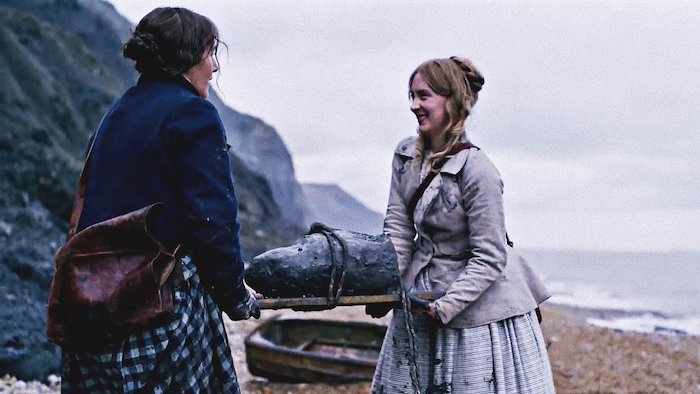
The changing palette of the film represents the physical and emotional growth between Mary and Charlotte; Lee, a fan of bad weather, obliges with a brighter palette, calm seas, and cheerfulness. When the two women hunt for fossils together, they even begin to look alike, both covered in mud, and shabbily dressed, skirts hiked up to better negotiate the cliffs. Significantly, as they dig, Charlotte removes her wedding ring. In one sunny scene, Mary actually laughs aloud when the two of them go swimming, stripped down to their chemises.
Charlotte shows an unexpected assertiveness when a male customer complains that a fossil in the shop is priced too high. Has he not considered, she asks, the skill and expertise involved in finding and preparing such a treasure? He pays the asking price.
But the idyll is ended when husband Roderick returns from his travels and summons Charlotte home to London. Molly dies in a very brief scene, leaving Mary alone. Her former lover, Katherine, pays a visit to express her condolences and to clear the air; she confesses that as much as she admires Mary, she always found her too distant.
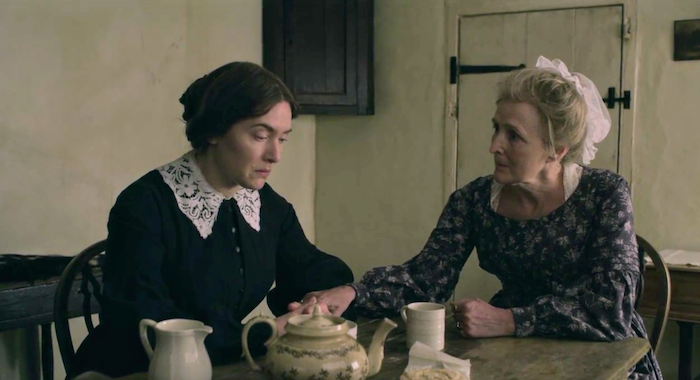
Mary is thrilled to receive an invitation from Charlotte to visit her in London and arrives by ship (arranged by Charlotte). Again the palette is vibrant, almost harsh, and Mary has bought new clothes for the occasion. She intends to also visit her “sea lizard” in the British Museum, but as she strides the London streets a brief glimpse of a servant scrubbing front door steps reminds us once more of what is considered women’s work. Despite her finery, Charlotte’s housekeeper directs her to the servants’ entrance. Mary is asked to wait in a luxurious drawing-room, where she recognizes a fossil on display—it’s the ammonite she sold Roderick. He has literally rewritten history by pasting a label over it claiming it’s his find. She peels it off, revealing the original with her name.
Restored to her privileged existence as the wife of a wealthy gentleman, Charlotte has Mary’s future all worked out, intending her to live in her house, as a trophy like a geological specimen in a case. Her arrogance is astounding, and Mary is shocked and insulted. She came for a visit. She has work to do. Our last glimpse of the two women is as they stand on either side of the display case, divided by a fossil.
Have you seen Ammonite? What did you think?



